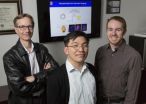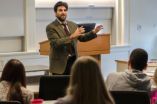(Press-News.org) Researchers at University of California, San Diego School of Medicine and Moores Cancer Center have used computer simulations of cancer cells – cancer avatars – to identify drugs most likely to kill cancer cells isolated from patients' brain tumors.
The findings, published in May 21 online issue of the Journal of Translational Medicine, may help researchers stratify cancer patients for clinical trials according to their cancers' genomic signatures and predicted sensitivities to different cancer drugs.
Such an approach would allow scientists to selectively test cancer drugs on those who would be most likely to respond to them, while simultaneously reducing patients' exposures to toxic drugs that would likely be ineffective.
"Genomics tells us that cancers are a lot like snowflakes. No two cancers are alike so it does not make sense to give all patients the same drugs. This is the idea behind personalizing therapies for cancer," said lead author Sandeep Pingle, MD, PhD, a project scientist in the laboratory of Santosh Kesari, MD, PhD, chief of the division of Neuro-Oncology, professor in the department of neurosciences, director of Neuro-Oncology at UC San Diego Moores Cancer Center and the study's senior author.
"With the virtual cell model, we can take into account all the complexity of cellular processes to predict which drugs will be the most effective against a particular tumor based on its genomic profile," Pingle said. "This is a first step toward personalized medicine."
Researchers developed a virtual cell that represents the internal workings of a normal, healthy cell, depicting them as a complex collection of signaling pathways and metabolic networks. The virtual healthy cell can be made cancerous. Indeed, it can be turned into any kind of cancer cell by distorting specific points and pathways in the system. These cellular distortions represent a person's so-called cancer avatar. Once the avatar is generated, a computer model predicts which drugs, based upon their known functions, are most likely to kill a real cancer cell.
For the study, researchers generated cancer avatars for cells obtained from patients with glioblastoma, a highly aggressive cancer of the brain's glial cells. The condition has a five-year survival rate of about 10 percent. The computer generated predictions were then "truth-checked" against standard, cultured cells in drug-sensitivity experiments.
"The advantage of computational modeling is the ability to incorporate the wealth of genomic and proteomic information on cancer cells and to screen drugs and combinations of drugs much faster and cost effectively," said Kesari. "Our ultimate goal is to take this technology to the clinic to identify the best drugs for treating each individual cancer patient."
INFORMATION:
Co-authors include Zeba Sultana, Shweta Kapoor, Ansu Kumar, Shahabuddin Usmani and Ashish Agrawal, Cellworks Research India Ltd.; Sandra Pastorino, Pengfei Jiang, Rajesh Mukthavaram,Ying Chao, Ila Sri Bharati, Natsuko Nomura and Milan Makale, UC San Diego Moores Cancer Center; Taher Abbasi, Cellworks Group Inc.; and Shireen Vali, Cellworks Research India Ltd. and Cellworks Group Inc.
The study was funded, in part, by the National Brain Tumor Society, Barbara and Joseph Ajello Trust Fund, Tuttleman Family Foundation, MCJ Amelior Foundation and Boston Fire Department/Kenney Foundation.
Cancer avatars for personalized medicine
Tumor modeling predicts most effective drugs targeting brain cancer
2014-05-21
ELSE PRESS RELEASES FROM THIS DATE:
Rhythmic bursts of electrical activity from cells in ear teach brain how to hear
2014-05-21
PITTSBURGH, May 21, 2014 – A precise rhythm of electrical impulses transmitted from cells in the inner ear coaches the brain how to hear, according to a new study led by researchers at the University of Pittsburgh School of Medicine. They report the first evidence of this developmental process today in the online version of Neuron.
The ear generates spontaneous electrical activity to trigger a response in the brain before hearing actually begins, said senior investigator Karl Kandler, Ph.D., professor of otolaryngology and neurobiology, Pitt School of Medicine. These patterned ...
NIH Pain Consortium's first pain care curriculum improves clinical skills
2014-05-21
An online training module designed for the evaluation and care of chronic pain greatly improved medical student clinical skills, according to a report in the Journal of the American Geriatrics Society. The module, built by the University of Pittsburgh and using an elderly woman with chronic lower back pain as a case study, is the first curriculum resource created through the efforts of the National Institutes of Health Pain Consortium's Centers of Excellence in Pain Education program (CoEPEs). The program was developed in response to the Affordable Care Act's mandate to ...
Illinois researchers combine weak chemical forces to strengthen novel imaging technology
2014-05-21
When University of Illinois Associate Professor of Chemical and Biomolecular Engineering Hyunjoon Kong, graduate student Cartney Smith, and colleagues set out to improve MR imaging (MRI), they turned current contrast agent technology on its head—or rather, they turned it inside out. The new compound they designed in collaboration with Illinois' Roger Adams Professor of Chemistry Steven C. Zimmerman is not only more effective, but also self-assembling. Kong is also a member of the Regenerative Biology and Tissue Engineering research theme at the Institute for Genomic Biology.
When ...
New study reveals corporate social responsibility can lead to better customer service
2014-05-21
Currently accepted wisdom in the corporate world is that in order to motivate frontline employees who serve customers, corporations need to increase their salary, make them feel more positive about the company, or give them more explicit instructions on how to interact with customers. A new study led by Drexel University's Daniel Korschun, PhD, an assistant professor at the LeBow College of Business, examines how frontline employees respond to corporate social responsibility (CSR) activities such as charitable giving, environmental programs and ethical practices. The study ...
New guidelines and technology needed for placement of feeding tubes in pediatric patients
2014-05-21
Universal guidelines and improvements in technology are needed to reduce injuries and deaths from improper placement of nasogastric feeding tubes in pediatric patients, according to a comprehensive review of published literature.
The review, conducted by the New Opportunities for Verification of Enteral Tube Location (NOVEL) Work Group Project of the American Society for Parenteral and Enteral Nutrition (A.S.P.E.N.) found that while the bedside placement of a nasogastric feeding tube is a common procedure conducted by nurses, incorrect placement can have serious and ...
New, fossil-fuel-free process makes biodiesel sustainable
2014-05-21
EAST LANSING, Mich. — A new fuel-cell concept, developed by an Michigan State University researcher, will allow biodiesel plants to eliminate the creation of hazardous wastes while removing their dependence on fossil fuel from their production process.
The platform, which uses microbes to glean ethanol from glycerol and has the added benefit of cleaning up the wastewater, will allow producers to reincorporate the ethanol and the water into the fuel-making process, said Gemma Reguera, MSU microbiologist and one of the co-authors.
"With a saturated glycerol market, traditional ...
Risky alcohol use in male-dominated industries
2014-05-21
New Rochelle, NY, May 21, 2014—The workplace can provide an ideal environment to implement support, well-being, and testing interventions aimed at reducing risky alcohol use among men. By targeting male-dominated industries, in particular, alcohol screening and prevention efforts may be effective in reducing alcohol use, according to a Review article in Journal of Men's Health, a peer-reviewed publication from Mary Ann Liebert, Inc., publishers. The article is available free on the Journal of Men's Health website.
A team of Australian researchers led by Nicole Lee, ...
Phase III clinical trial shows image fusion-guided biopsy significantly improves accuracy of prostate
2014-05-21
NEW HYDE PARK, NY – A recent study by investigators from LIJ Medical Center demonstrated that using magnetic resonance imaging (MRI) in men with an elevated prostate specific antigen (PSA) resulted in a prostate cancer detection rate that was twice as high as data reported in the March 1999 Prostate journal that analyzed men undergoing the standard 12-core biopsy with an elevated PSA. Physicians in the recent trial used a targeted approach to evaluate prostate cancer that combines MR imaging and transrectal ultrasound fusion guided prostate biopsy.
Given the limitations ...
Carnegie Mellon, Microsoft Research automate privacy compliance for big data systems
2014-05-21
PITTSBURGH—Web services companies, such as Facebook, Google and Microsoft, all make promises about how they will use personal information they gather. But ensuring that millions of lines of code in their systems operate in ways consistent with privacy promises is labor-intensive and difficult. A team from Carnegie Mellon University and Microsoft Research, however, has shown these compliance checks can be automated.
The researchers developed a prototype automated system that is now running on the data analytics pipeline of Bing, Microsoft's search engine. According to ...
Funny River Fire, Alaska
2014-05-21
According to the Alaskan Division of Forestry the Funny River fire was very active overnight (May 20) because of low humidity. Currently the fire is estimated to be near 7,000 acres and has reached Tustumena Lake. It is spreading east and west along the shore, is 10 miles long, and is about a mile wide with broadening at the lake shore. There have been no evacuations or reports of any structures lost.
Early this morning (May 21), flame lengths of 125 feet with erratic fire behavior were reported. Winds for today are forecasted to remain out of the north keeping the fire ...
LAST 30 PRESS RELEASES:
Drone sampling of whale breath reveals first evidence of potentially deadly virus in Arctic
Roman soldiers defending Hadrian’s Wall infected by parasites, study finds
Pinochet’s prisoners were tormented with music but still found solace in it, a new book reveals
Fertility remains high in rural Tanzania despite access to family planning
AI-assisted device can improve autism care access
Kinetic careers
Uncovering how parasitic plants avoid attacking themselves to improve crop resistance
Nanoparticle vaccine strategy could protect against Ebola and other deadly filoviruses
Study finds brain care score can predict risk of stroke across racial groups
Key lung immune cells can intensify allergic reactions
Do hormones explain why women experience more gut pain?
New materials conduct ions in solids as easily as in liquids
Breakthrough of the Year: Renewable energy begins to eclipse fossil fuel-based sources
LLM use is reshaping scientific enterprise by increasing output, reducing quality and more
Introducing LightGen, a chip for ultra-fast, ultra-efficient generative AI
Astronomers see fireworks from violent collisions around nearby star
ACC/AHA issue new guideline on managing congenital heart disease in adults
Cosmic crash caught on camera
Is talented youth nurtured the wrong way? New study shows: top performers develop differently than assumed
Ants: An untapped resource in the development of antibiotics?
Archaeologists use AI to create prehistoric video game
Mitochondria migrate toward the cell membrane in response to high glucose levels
Tiny viral switch offers hope against drug-resistant bacteria
Most parents aware of early peanut introduction guidelines, but confused about details
HPV vaccine can protect against severe lesions of the vulva and vagina
Virtual care provision and emergency department use among children and youth
Quadrivalent HPV vaccine and high-grade vulvovaginal lesions
Insights into dry eyes gained from stem cell-derived tear glands
Researchers identify 166 human pluripotent stem cell lines available for use in clinical applications
Europa Clipper instrument uniquely observed interstellar comet 3I/ATLAS
[Press-News.org] Cancer avatars for personalized medicineTumor modeling predicts most effective drugs targeting brain cancer





